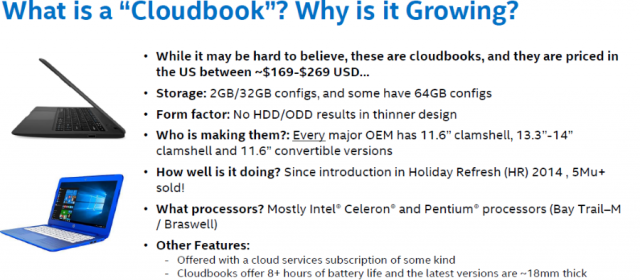
Last week, Intel announced its new Apollo Lake low-cost series of Pentium, Celeron, and Atom products due to launch in the back half of 2016. Goldmont, the CPU core that powers Apollo Lake, is the next iteration of the Silvermont architecture that replaced Intel’s original Bonnell architecture, which powered Atom from 2008 – 2012.
2-in-1’s have been the PC industry’s sole bright spot in recent years, and while they haven’t grown quickly enough to offset the general decline in desktop and laptop sales, they have picked up steam in retail at a reasonable clip. Intel’s low-cost Apollo Lake platform is meant to accelerate that transition by pushing a variety of ultra thin-and-light devices. What’s interesting is, Intel is explicitly targeting “Cloudbooks,” like Google’s Chromebook, and calling them out as an important segment in the $169 – $269 price band.

The entire point of Apollo Lake is to cut developer costs compared with previous generations, a fact made obvious by the slide below:

If you add up all the cost savings Intel is promising on this slide, it comes to $7.45. This should tell you something about just how thin PC profit margins are at the bottom end of the market — not only did Intel feel it was important to break these savings out by sector, but the total amount comes to the approximate total of a combo meal at a fast food chain. On the other hand, if you’re selling a device for $169, $7.45 is 4.4% of your total — and as we’ve seen, PC manufacturers often have net profit margins in the 3-4% range.
What’s inside Goldmont?
Intel isn’t talking at all about what kind of performance Goldmont will offer, and that’s a bit concerning. Prior to the launch of Silvermont / Bay Trail, Intel was more than happy to talk up the new chip’s core counts, performance, and anticipated per-core efficiency increases. Bay Trail offered a huge performance jump over Atom, competed well against AMD’s Kabini, and gave Intel a foothold in tablets and low-cost 2-in-1’s. Cherry Trail, which debuted last year in Microsoft’s Surface 3, took the Silvermont architecture to 14nm (Airmont), but didn’t really offer much in the way of battery life improvements. GPU performance increased significantly, but battery life was a wash.

It’s smaller. Is it faster?
This highlights a problem with modern devices that Intel may have a hard time fixing. The rush to include high-end displays at every price point can be good for consumers, but it can also shove OEMs towards devices that really shouldn’t carry such ridiculous resolutions. These resolutions require higher backlight power and there’s a baseline per-pixel power consumption rate on top of that. In short, it’s easy for laptops to soak up all the power improvements that Intel can deliver by equipping them with more powerful displays. This creates a feedback loop in which Intel builds higher-end GPUs (that can drive the higher resolution displays), which requires more power, which eats away at the CPU’s power budget.
At the same time, however, it’s hard not to see Goldmont as critical if Intel has any aspirations left for the tablet or smartphone market. Silvermont was a good chip — it hit all Intel’s internal targets and it offered a much better x86 tablet experience than Clover Trail ever could. Ultimately, however, it mostly anchored low-end Android and x86 tablets, and was outperformed by some of ARM’s higher-end offerings (Apple’s own cores remain in a class by themselves). Goldmont could change that if Intel builds a core with substantially better IPC, but it has to do so at a price point that makes sense and at a net cost that allows it to compete against Qualcomm, Samsung, and other ARM vendors.
The company’s silence on the base architecture is concerning. The GPU specs should be excellent, but GPU alone won’t win Intel mobile business
[Source:- Extremetech]

